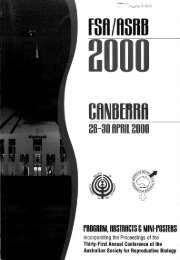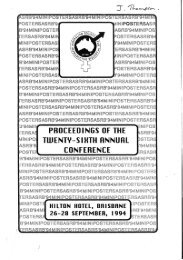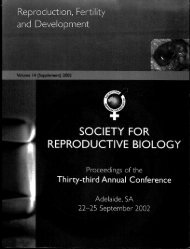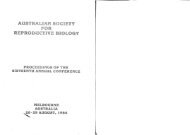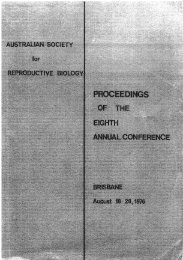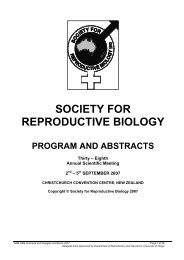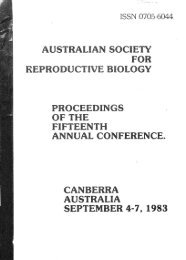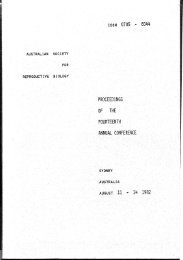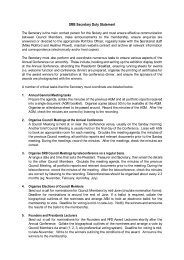N OCIETY' - the Society for Reproductive Biology
N OCIETY' - the Society for Reproductive Biology
N OCIETY' - the Society for Reproductive Biology
Create successful ePaper yourself
Turn your PDF publications into a flip-book with our unique Google optimized e-Paper software.
Cloning and Characterisation ofa Novel Testis Transcript with Homology toPhosphatidylethanolamine Binding Proteins - pebp2ISOLATION AND PARTIAL CHARACTERISATION OF THE OUTER DENSE FmRES FROM BRUSH·TAILED POSSUM SPERMATOZOAM. RiccI and W.O. BreedDepartment of Anatomical Sciences, The University of Adelaide, S.A., 5005Deborah M. Hickox l , John R. Morrison l , Kimberley L. Sebire l , Hooi-Hong Keah 2 , Milton T.W. Hearn 2 ,David M. de Kretser 1 , Moira K. O'BryanIllnstitute of Reproduction and Development and The Centre <strong>for</strong> Bioprocess Technology,2Department of Biochemistry, Monash University, Clayton, Victoria, 3168, Australia.IntroductionMany infertile men show an increased percentage of abnormally shaped and immotile sperm arising fromunknown factors. It is postulated that some of <strong>the</strong>se abnormalities arise from mutations in genes criticallyrelated to <strong>the</strong> <strong>for</strong>mation of <strong>the</strong> spermatozoa. To gain a better understanding of <strong>the</strong> mechanisms underlyingsperm development and function we set out to clone rat cDNAs involved in spermiogenesis. A previouslyunreported partial cDNA transcript was isolated and designated pebp2 based on <strong>the</strong> possession of a putativephosphatidylethanolamine binding protein (PEBP). The aims of <strong>the</strong> present study were to clone <strong>the</strong> fulllength rat pebp2 transcript, its mouse orthologue and to initiate a functional characterization.Materials and MethodsThe remainder of <strong>the</strong> rat pebp2 cDNA was obtained using a 5' rapid amplification of cDNA ends (RACE)method. The orthologous mouse sequence was obtained by screening a mouse testis lambda expressionlibrary. Isolated clone sequences and <strong>the</strong>ir predicted encoded proteins were compared against databaseentries <strong>for</strong> homology and _sequence motifs, using <strong>the</strong> BLAST and Prosite programs respectively. Peptidesspecific <strong>for</strong> pebp2 were produced using Fmoc-based chemistry and were linked to keyhole limpethaemocyanin (KLH). Peptide-KLH conjugates were immunized into rabbits to raise pebp2-specific antisera<strong>for</strong> use in immunohistochemical techniques. Nor<strong>the</strong>rn blotting and in situ hybridization were carried out todetermine <strong>the</strong> timing of pebp2 mRNA expression during spermatogenesis. RNA extracted from male andfemale Balb/c mice tissues were used <strong>for</strong> RT-PCR analysis oftissue distribution.Results5' RACE was successfully used to obtain an additional -1 kb of rat pebp2 cDNA sequence. Nor<strong>the</strong>rnanalysis revealed 2 encoded transcripts of -1.6kb and -3.0kb which were up-regulated at day 25 and day 35post-partum, respectively. Screening of a mouse testis expression library identified a novel cDNA sequencewhich shared 93% homology in <strong>the</strong> coding region with <strong>the</strong> rat pebp2 sequence. In agreement with rat pebp2expression, mouse pebp2 mRNA was expressed in late pachytene spermatocytes and round spermatids. Thisresult was supported by immunohistochemical staining data which showed pebp2 protein in round andelongating spermatids and on sperm heads at spermiation. One of <strong>the</strong> six mouse pebp2 clones sequenced wasthought to represent an alternative splice variant which would result in an in-frame deletion of 14 aminoacids. This was supported by RT-PCR analyses. The long mouse iso<strong>for</strong>m was predicted to have a Mr of-21.2kDa and an isoelectric point (pI) of -8.43. The short iso<strong>for</strong>m was predicted to have a Mr of -19.9 kDaand pI of -8.77. Both <strong>the</strong> predicted mouse and rat proteins contained a PEBP family signature, severalpotential phosphorylation sites and a nuclear localization signal. Tissue expression studies revealed <strong>the</strong>presence of both <strong>the</strong> short and long iso<strong>for</strong>ms of mouse pebp2 in many tissues including brain, heart, kidney,liver, lung, skeletal muscle. In addition a putative human orthologue has been identified by searching <strong>the</strong>EST database. The predicted protein sequences from all three species were novel and more closely related toone ano<strong>the</strong>r than o<strong>the</strong>r previously identified members of <strong>the</strong> PEBP family.ConclusionWe have identified novel rat and mouse testis transcripts and proteins which we have designated pebp2 basedon <strong>the</strong> possession of a PEBP motif. Mouse pebp2 is predicted to encode two potentially phosphorylationregulatediso<strong>for</strong>ms of -21 and 20kDa which are expressed during spermiognesis. Fur<strong>the</strong>r, pebp2 isofonnsappear to be integral component of several tissues throughout <strong>the</strong> body. The involvement of pebp2 in spermepididymal maturation, capacitation and fertilization is <strong>the</strong> subject of fur<strong>the</strong>r research.IntroductionIn all <strong>the</strong>rian mammals, nine prominent cytoskeletalstructures, <strong>the</strong> outer dense fibres, surround <strong>the</strong>axoneme of <strong>the</strong> midpiece and principle piece of <strong>the</strong>sperm flagellum (Figure 1). The possible function(s)of <strong>the</strong> outer dense fibres may be to ei<strong>the</strong>r maintain <strong>the</strong>passive elastic recoil of <strong>the</strong> sperm flagellum (1)and/or to protect <strong>the</strong> flagella against shearing <strong>for</strong>cesduring epididymal transit (2). The isolation andcharacterisation of <strong>the</strong> outer dense fibres from rat,bull and human sperm have been previously reported(3, 4, 5), but as yet no study has been published <strong>for</strong>any marsupial species. The aim of <strong>the</strong> present study,which is part of a broader investigation of <strong>the</strong>evolution of eu<strong>the</strong>rian and marsupial gametes, was toisolate and determine <strong>the</strong> protein composition of <strong>the</strong>outer dense fibres <strong>for</strong> <strong>the</strong> first time in a marsupialspecies, <strong>the</strong> brush-tailed possum, Trichosurusvulpecula-.Materials & MethodsSpermatozoa obtained from <strong>the</strong> cauda epididymidesof 10 adult possums were decapitated by sonication,layered over a 20%,40% and 60% (w/v) sucrose stepgradient and centrifuged at 2500 x g <strong>for</strong> 120 minutesat 4°C. Sperm flagella fractions were collected from<strong>the</strong> 40-60% interface and purity was assessed byNomarski microscopy. Sperm flagella were pelletedand incubated in 1% sodium dodecyl sulfate (SDS),2mM dithiothrietol (DIT), 25mM Tris-HCI (pH 8.0),and shaken at room temperature <strong>for</strong> approximately 90minutes. The resultant suspension was layered over a20%, 40% and 60% (w/v) sucrose step gradient,centrifuged, and <strong>the</strong> outer dense fibres were collectedfrom <strong>the</strong> 40-60% interface. The isolated outer densefibres were ei<strong>the</strong>r fixed <strong>for</strong> routine transmissionelectron microscopy and/or solubilised with 2% SDS5% B-mercaptoethanol <strong>for</strong> 5 minutes at 100°C andrun on linear gradient (7.5-15%) SDS polyacrylamidegels which were stained with Coomassie.Results and DiscussionSeparation of flagella from <strong>the</strong> sperm head bysonication and subsequent sucrose density gradientcentrifugation resulted in a high yield of flagella from<strong>the</strong> 40-60% interface. Incubation of <strong>the</strong> sperm flagellain SDS-DIT <strong>for</strong> 90 minutes resulted in <strong>the</strong> completesolubilisation of <strong>the</strong> axoneme, mitochondria andfibrous sheaths but <strong>the</strong> outer dense fibres remainedintact (Figure 1). SDS-polyacrylamide gels of <strong>the</strong>outer dense fibre fractions revealed 5 majorpolypeptide bands with molecular masses of 73, 57,52, 42 and 16 kDa, <strong>the</strong> last of which was <strong>the</strong> mostprominent band (Figure 2). In comparison, rat, bulland human sperm outer dense fibres contain 7, 3 and2 major polypeptides respectively (3, 4, 5), and <strong>the</strong>most prominent bands in rat and bull outer densefibres are 27 kDa and 33 kDa in mass (3, 4).f'~8·"'.tt." I'.., '•. '.·.,.< ~:;1 ;Figure 1. Electron micrograph of isolated possum outer dense fibres; in~et:transverse section of principle piece of possum sperm flagellum showmgouter dense fibres (arrows).Figure 2. SDS-PAGE of isolated possum outer dense fibres (ODF) andmolecular weight standards (STD).ConclusionsThe isolation and molecular weights of <strong>the</strong> proteins of<strong>the</strong> outer dense fibres has been described <strong>for</strong> <strong>the</strong> fIrsttime in a marsupial species, <strong>the</strong> brush-tailed possum.Polyc1onal antibodies are currently being raisedagainst <strong>the</strong> major possum outer dense fibrepolypeptides and <strong>the</strong>se will be used toimmunocytochemically investigate <strong>the</strong> developmentand localisation of <strong>the</strong>se cytoskeletal structures. Inaddition, techniques are currently being developed tosimilarly isolate and characterise <strong>the</strong> proteins of <strong>the</strong>o<strong>the</strong>r major cytoskeletal component of <strong>the</strong> possumsperm flagellum, <strong>the</strong> fibrous sheath.References(1) Phillips DM (1972) J. Cell Biol.53: 561-573.(2) Baltz JM et al. (1990). Biol. Reprod. 43: 485491.(3) Oko R (1988) BioI. Reprod. 39: 169-182.(4) Brito et ai. (1986) Gamete Res. 15: 327-336.(5) Henkel et al. (1992). BioI. Chern. Hoppe-Seyler373: 685-689.2108109



